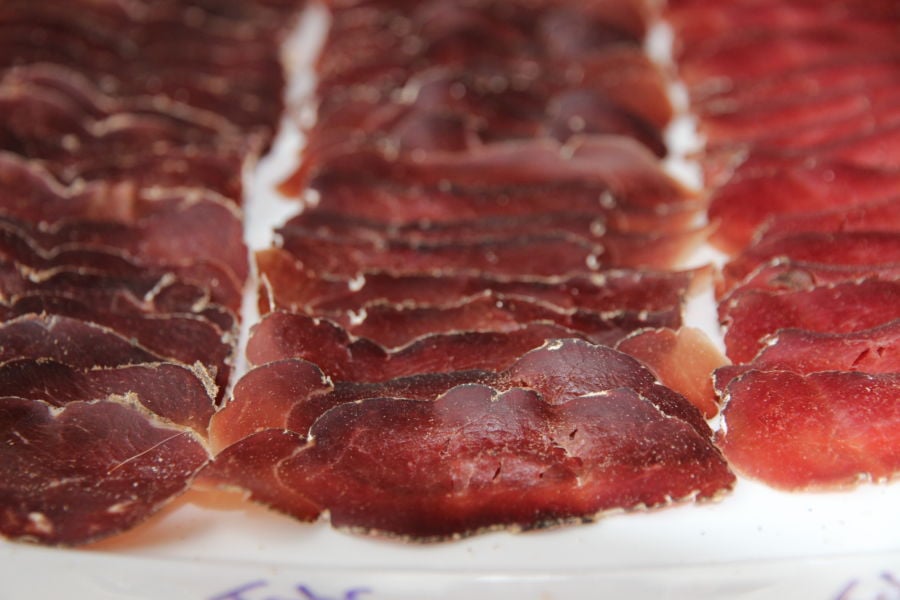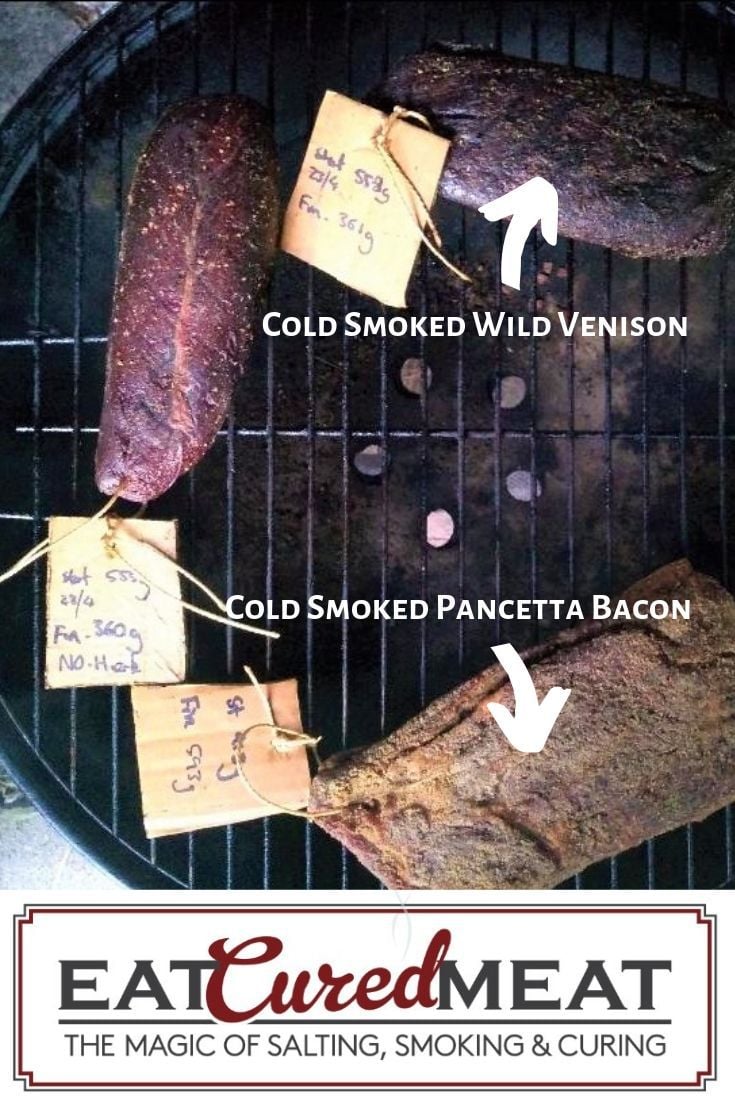Pink curing salt or Prague powder can be used in many different ways (and there are many other names for it).
I would like to explain how I use pink-curing salt and provide details that may be helpful to someone new to this product.
Summary Points:
- Pink curing salt is used to cure bacon, pastrami, and ham, whether homemade or commercially produced.
- It comes in two types, pink curing salt #1 and #2, with different sodium nitrite and nitrate percentages for various curing durations.
- Pink curing salt can contain sodium nitrite and/or nitrate, which protect against botulism and gives cured meat a characteristic pinkish-red color.
- Equilibrium curing ensures precise ratios of salt and pink curing salt based on meat weight, resulting in uniform curing and flavor.
- Different names and variations exist worldwide, with European standards having different nitrite/nitrate ratios.
- It’s an optional choice to use this product based on the process and method of curing meat.
Pink curing salt is commonly found in many popular foods, including those produced at home or commercially, such as pastrami, bacon, corned beef, pancetta, and various hams.
This website, Eat Cured Meat, is dedicated to curing meat, so over the last 15 or 20 years, I’ve been using pink curing salt as part of my recipes for salami, pancetta, bresaola, and many other cured meat projects.
There have been some improvements in how pink curing salt has been calculated. I’ll go over with you how it’s used for large-volume projects, small-at-home curing, or charcuterie projects.

My brother has put together an equilibrium curing calculator, this is a very popular tool that works out the salt percentage to the total weight of the meats used for curing. This calculator also calculates 0.25% of the pink curing salt, regardless of whether it is pink curing salt #1 or #2; the percentage of pink curing salt remains the same.
There is a link at the top of each page, or you can find that pink curing salt and the equilibrium curing calculator here.
What is Pink Curing Salt?
Pink curing salt is either No. 1 or No. 2.
| Type | Salt Amount | Sodium Nitrite | Sodium Nitrate | Uses | Examples |
| Pink Curing Salt #1 | 93.75% | 6.25% | – | Under 30-Day Cured & Cooked Meat | Pastrami, Luncheon Hams, Corned Beef |
| Pink Curing Salt #2 | 89.75% | 6.25% | 4.00% | Under 30-Day Cured & Cooked Meat | Dry Cured Salami, Braesola, Country Ham, Lonza, Coppa, Pancetta |
Pink Curing Salt is:
Salt (NaCl) – basically sea salt/sodium chloride
Sodium nitrite (NaNO2) – helps protect the meat from unwanted bacteria.
Sodium nitrate (NaNO3) – for over 30-day curing, sodium nitrate breaks down to sodium nitrite as the curing progresses. It converts and breaks down.
A color change is used with pink curing salt. The meat takes on a red or pinkish hue, which is a reaction occurring within the myoglobin in the meat. You’ll notice that most commercially produced cured meats, such as hams or bacon, have a pinkish, reddish color.
When I do not use nitrites or nitrates in my homemade cured meats, the meat stays a more neutral color.
How to Use Pink Curing Salt?

Most of the pink curing salt packages I’ve seen indicate a commercial quantity and ratio of use.
Pink curing salt is generally written as 4 ounces should be used for 100 pounds of meat.
The way I work out my meat curing is to decide on the amount of saltiness using the modern equilibrium curing, so let’s say 3% salt for making braesola.
I use 2.75% salt + 0.25% pink curing salt #2 equals total 3% salt
Since the majority of pink curing salt is ‘salt’ with the nitrate/nitrites.
For example,
1000 grams of meat
= 27.5 grams of salt
= 2.5 grams of pink curing salt #2
Here is a table to highlight the different amounts; whether it is No.1 or No.2 the amounts are the same:
| Amount of Meat | Pink Curing Salt Amount (ounces) | Pink Curing Salt Amount (grams) |
| 100 pounds | 4 (0.25%) | 113.4 grams (0.25% |
| 5 pounds | 0.2 (0.25%) | 5.66 grams (0.25%) |
There are two methods of using pink curing salt for meat curing: either a brine or a dry cure. Above the table is dry curing.
A brine is a type of curing that involves mixing water and salt, sometimes referred to as pickling or wet brining.
A ratio of 1 teaspoon per 5 pounds of meat is the guide for brining. However, one must calculate the amounts of brine and salt.
My preference is using an ‘equilibrium’ brining method; I have also created a calculator for this.
For Equilibrium Curing at home, 0.25% of the meat weight means accurate scales are essential for measurement. Here is a page of scales I can recommend.
Why to Use Pink Curing Salt?
When curing meat, canning, and brining, it is protected from unwanted bacteria, using pink curing salt in the correct ratio can avoid bacteria such as botulism.
Taste and color are also factors; a grey-looking ham is one factor for its use.
Effects of Nitrates and Nitrites
According to the textbook, in the production of quality meats and sausages (Marianksi & Marianksi), adding nitrates will improve flavor, prevent food poisoning, tenderize the meat, and develop the pink color widely associated with smoked meats.
Different Names for Pink Curing Salt
Here is a list of pink-curing salt with the same ratio of salt, nitrates & nitrites.
| Under 30 Days Pink Curing Salt #1 | Over 30 Days Pink Curing Salt #2 |
| Pink Curing Salt #1 | Pink Curing Salt #2 |
| Prague Powder #1 | Prague Powder #2 |
| Quick Cure #1 | Quick Cure #2 |
| Instacure #1 | Instacure #2 |
| Tinted Curing Mix (TCM) #1 | Tinted Curing Mix (TCM) #2 |
Here are curing salts with different ratios of nitrates/nitrites – this is due to European Meat Curing standards (many of these have 0.6% of nitrite in the salt vs. 6.25% for curing salt #1) – therefore, my calculator is not applicable.
- Colorazo – Sweden
- Sel Nitrite – France
- Peklosol – Poland
- Nitrited Salt – England
There are Other brands like Tender Quick. I have not used or had experience with these so that I won’t comment here.
TenderQuick—Depending on the product, these all contain different amounts of sugar, nitrites, and nitrates. They are similar to pink curing salt, but it is best to follow the instructions on the packaging. These products are popular in Canada.
Precautions About Pink Curing Salt
Salumi, a meat-curing book by Ruhlman and Paulson, summarizes curing salts like this,
Nitrates and nitrates are naturally occurring chemicals that our bodies rely on. Green vegetables such as spinach and celery are loaded with them. As much as 95% of the nitrates in our bodies comes from vegetables. Our bodies naturally convert nitrates into nitrites which work as a powerful antibacterial agent, particularly and an acidic environment (such as our stomachs).
Nitrates and nitrites provide same antibacterial function and the sausage it’s been cured. Lactobacillus bacteria, feeding on sugars in the sausage, produce acid(that is the tanginess we associate with salami) and the nitrates keep harmful microbes from growing – most importantly, the bacterium that generates the deadly botulism.”
Here is a scientific paper about the health benefits of nitrates/nitrites from fruit and veg – Food sources of nitrates and nitrites: the physiologic context for potential health benefits
Pink curing salt is used at very minimal levels when I am doing a few pounds of dry-cured meats. A very small percentage of 1 teaspoon is used as part of the ingredients.
Pink curing salts are something that should be double or even triple-checked to make sure you have the right amount.
In contrast, pink curing salts, when used correctly and in the correct ratios, add a level of protection to the curing project—this is why I use them.
From the textbook Home Production of Quality Meats and Sausages, it states,
Carcinogens can only be formed when products are heated above 266°F or 130°C. This can only happen when cured bacon is fried or cured salamis I grilled. The majority of cured meats never reach such high temperatures.
Page 51, Marianski & Marianski – Home Production of Quality Meats and Sausages
What If the Wrong Amount of Pink Curing is Used
If the pink curing salt is misused, the meat may exhibit two distinct shades of color. This is also why equilibrium curing is an excellent way to use pink-curing salt at home.
When I have cured pieces of meat with equilibrium, I use the right amount of salt and 0.25% curing salt. Once this meat has been vacuum packed, you can put it into the fridge. Depending on the size, I would generally leave it for 2 to 4 weeks.
However, on occasion, I forgot about it, and even after three or four months, the meat has been sitting in an oxygen-low environment, cured and ready for the next step. I removed it and hung it in my homemade DIY curing chamber.
Useful Links & Resources

Tom Mueller
For decades, immersed in studying, working, learning, and teaching the craft of meat curing, sharing the passion and showcasing the world of charcuterie and smoked meat. Read More
